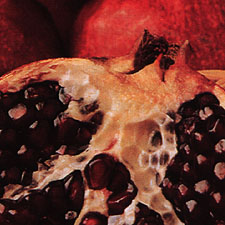
FoodFood InformationFruitTropical
The pomegranate dates back to ancient Persia. It is a most unusual fruit
that resembles no other in structure. While it is far from a household word
in most areas of North America, it is very popular with people of eastern
Mediterranean, Near Eastern, and Far Eastern backgrounds. Our entire pomegranate
crop is produced in California, and much of this crop is exported. The pomegranate
has a short season, from October to January. Although they are also grown
in the Southern Hemisphere, they are seldom imported during America's off-season.
Pomegranates grow on trees, and the round, bright, red-skinned fruits look
like Christmas tree ornaments when they reach full color. There are also
some golden-yellow varieties, but these are not grown commercially. Most
of the ones grown in California are of a variety that is modestly called
Wonderful. The skin of the pomegranate is leathery and parchment
like in texture. The flesh is honeycombed with hundreds of ruby-red kernels,
each chock full of juice and containing one rather firm but small, chewable
seed. As with grape seeds, you can either chew them or discard them, but
they are quite chewy. While some may consider the seeds a nuisance, the
fruit is very tasty and very juicy. It has a most refreshing tart-sweet
flavor. It is almost as juicy as a citrus fruit and is often squeezed to
yield its red juice, which is used to make grenadine syrup. This
claret colored juice is almost indelible. Long before the introduction of
paper and ink, the ancient Egyptians used pomegranate juice to write on
papyrus. They also used it to dye fabrics.
Most adults don't have the time it takes to eat a pomegranate. However,
to children the pomegranate is both a fruit and a toy. They are fascinated
by the jewel like kernels. Since the juice is almost indelible, it can create
a most colorful mess if given to an unattended youngster. Pomegranates need
not be refrigerated, but refrigeration won't hurt and will extend their
shelf life.

WHEN TO BUY: At peak October and November
WHAT TO LOOK FOR: Firm, colorful, not bruised fruit
HOW TO STORE: No refrigeration required
Deamer 5/97